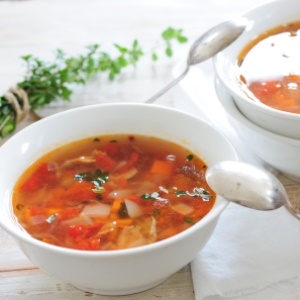
In winter we tend to crave hot comfort foods. Soup is an excellent choice, and with a few adaptations it can be a one of the healthiest foods on your menu. Here are some quick tips to make sure your winter soups are healthy and packed with nutrient-rich ingredients.
Fill up on phytonutrients
Phytonutrients are bioactive plant components found in fruit, vegetables and whole grains that are beneficial to our bodies and help to reduce the risk of chronic disease. Different coloured veggies provide an assortment of phytonutrients, all of which have different health benefits.
Read: The 4 key types of phytonutrients
The more colours you have in your soup bowl the better. Examples of different phytonutrients include:
Red tomatoes contain lycopene that potentially reduces the risk of prostate cancer and helps to preserve bone health. A beetroot and roasted red pepper soup, or tomato soup with crushed cashew nuts and fresh basil are just some examples of delicious and nutritious soups to try.
Orange carrots and butternut provide beta-carotene that aids with improved antioxidant defence, thereby supporting the immune system.
Read: Carrots
White onions and garlic form the perfect flavour base for most soups, so it is good to know that they provide diallyl sulphides that promote heart health and support the immune system.
Green spinach, kale and any dark green vegetables provide lutein that helps protect your eyes and may reduce the risk of developing certain cancers.
Reduce the energy
A big trap that may leave your jeans feeling tighter by the end of winter is the consumption of energy dense soups that contain too many kilojoules. Make the following simple changes to the soups you buy or prepare at home:
- Use water or tomato based soups rather than cream, as cream is high in saturated fats and energy. One can use a small amount of crushed nuts or low fat plain yoghurt or milk mix with some corn flour for a creamier tasting soup.
- Include lean proteins such as skinless chicken, fish or shellfish. Swap a lamb based soup for a delicious seafood soup to create a drop total energy.
- Plant protein sources such as chickpeas, lentils and red kidney beans can be added to vegetable based soups. They provide protein to keep you fuller for longer and are packed with nutrients and valuable fibre. They are low in energy and cost less than animal protein.
- Avoid adding grated cheese, cream, or croutons as toppings. Rather try sprigs of fresh herbs like basil or a spoon of hummus or roasted nuts and seeds for crunch.
Replace the salt
Commercial soups can contain additional sodium. Homemade soups can be prepared using these tips to keep the sodium content low.
- The best option is to use homemade stock using vegetables and meaty bones to make a broth and use this as a base. As this is might not always be possible, use reduced salt stock cubes.
- Reduce the amount of salt in the recipe by at least fifty percent, and avoid adding any salt when you are using commercial stock cubes or powder.
- Flavour food with fresh herbs and spices instead of salt to reduce the total sodium content.
Read: Which foods have sodium?
It’s always better to make your own soup as you can decide on the ingredients you would like to use. On the other hand, readymade soups can be real time savers. We did a nutrient profiling on over 40 different soups currently available on the market, and the examples below achieved the highest marks according to their nutritional profiles:
- Woolworth’s Fresh Hearty Homestyle Vegetable Soup
- Woolworth’s Smokey Beef and Chipotle Soup
- Woolworth’s Harissa Chicken, Pumpkin and Quinoa Soup
- Woolworth’s Fresh Chunky Vegetable Soup
- Pick n Pay’s Creamy Butternut Soup
- Woolworth’s Fresh Spinach, Broccoli and Kale Soup
Read more:
Fruit, veg extracts boost immunity
References:
Rui Hai Liu. Dietary Bioactive Compounds and Their Health Implications. Journal of Food Science. Vol. 78, S1, 2013.
LK Mahan, S Escott Stump, JL Raymond. Krauses Food and Nutrition Care Process. Missouri; 2012.




 Publications
Publications
 Partners
Partners










